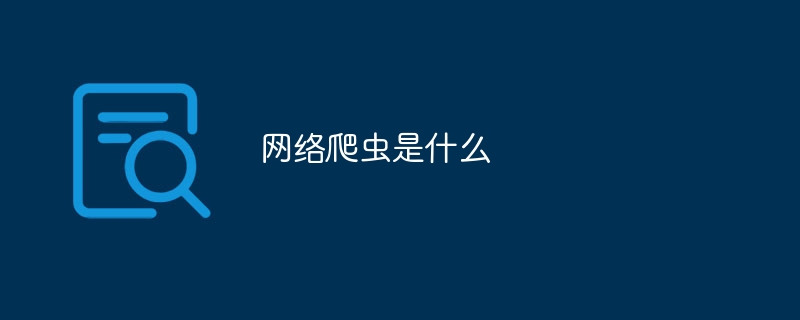Golang crawler refers to a program written in golang. By simulating client requests, accessing designated websites, and analyzing and extracting the content of the website, it can automatically obtain data, analyze competing products, monitor websites, etc. It will be of great help. Learning golang crawler can not only improve your technical level, but also better cope with the growing information needs. Crawler technology is widely used in information capture, data mining, website monitoring, automated testing and other fields.

The operating environment of this tutorial: windows10 system, golang1.20.1 version, DELL G3 computer.
Nowadays, with the continuous development of Internet technology, web crawling has become a very important skill. As an emerging programming language, golang has been widely used. This article will introduce you to how to use golang crawler.
What is golang crawler?
golang crawler refers to a program written in golang, which simulates client requests, accesses specified websites, and performs operations on the content of the website. Analysis and Extraction. This crawler technology is widely used in information capture, data mining, website monitoring, automated testing and other fields.
Advantages of golang crawler
As a static compiled language, golang has the characteristics of fast compilation speed, strong concurrency capability, and high operating efficiency. This gives the golang crawler the advantages of fast speed, good stability, and high scalability.
golang crawler tools
Third-party libraries
golang has a wealth of third-party libraries that can easily perform HTTP requests, HTML parsing, and concurrency Processing and other operations. Some of the important third-party libraries include:
net/http: used to send HTTP requests and process HTTP responses; net/url: used to process URL strings; goquery: a jQuery-based HTML parser, used Used to quickly find and traverse elements in HTML documents; goroutines and channels: used to implement parallel crawling and data flow control. Framework
golang also has some specialized crawler frameworks, such as:
Colly: a fast, flexible, and intelligent crawler framework that supports XPath and regular expression matching methods, and integrates Multiple advanced features, such as domain name limitation, request filtering, request callback, cookie management, etc. Gocrawl: A highly customizable crawler framework that supports URL redirection, page caching, request queuing, link speed limiting and other features. It also provides a comprehensive event callback interface to facilitate secondary development by users.
Golang crawler implementation steps
Sending HTTP requests
In golang, sending HTTP requests is implemented based on the standard library net/http. By creating an http.Client object and using its Do method to send HTTP requests and receive responses. The following is sending HTTP Code example for GET request:
import (
"net/http"
"io/ioutil"
)
func main() {
resp, err := http.Get("http://example.com/")
if err != nil {
// 处理错误
}
defer resp.Body.Close()
body, err := ioutil.ReadAll(resp.Body)
if err != nil {
// 处理错误
}
// 处理返回的内容
}Parsing HTML
In golang, parsing HTML is implemented based on the third-party library goquery. Using goquery, you can quickly find and traverse HTML elements through CSS selectors and other methods. The following is a code example for parsing HTML:
import (
"github.com/PuerkitoBio/goquery"
"strings"
)
func main() {
html := `
Link 1
Link 2
Link 3
`
doc, err := goquery.NewDocumentFromReader(strings.NewReader(html))
if err != nil {
// 处理错误
}
doc.Find("ul li a").Each(func(i int, s *goquery.Selection) {
// 处理每个a标签
href, _ := s.Attr("href")
text := s.Text()
})
}Parallel processing
Golang, as a concurrent programming language, has excellent parallel capabilities. In crawlers, parallel processing of multiple requests can be achieved through goroutines and channels. The following is a code example of parallel processing:
import (
"net/http"
"io/ioutil"
"fmt"
)
func fetch(url string, ch chan<- string) {
resp, err := http.Get(url)
if err != nil {
ch <- fmt.Sprintf("%s: %v", url, err)
return
}
defer resp.Body.Close()
body, err := ioutil.ReadAll(resp.Body)
if err != nil {
ch <- fmt.Sprintf("%s: %v", url, err)
return
}
ch <- fmt.Sprintf("%s: %s", url, body)
}
func main() {
urls := []string{"http://example.com/1", "http://example.com/2",
"http://example.com/3"}
ch := make(chan string)
for _, url := range urls {
go fetch(url, ch)
}
for range urls {
fmt.Println(<-ch)
}
}Summary
golang crawler is a very promising skill that can bring great benefits to us in automating data acquisition, analyzing competitive products, monitoring websites, etc. s help. Learning golang crawler can not only improve our technical level, but also allow us to better cope with the growing information needs.
The above is the detailed content of What is golang crawler. For more information, please follow other related articles on the PHP Chinese website!
 如何使用PHP编写一个简单的网络爬虫Jun 14, 2023 am 08:21 AM
如何使用PHP编写一个简单的网络爬虫Jun 14, 2023 am 08:21 AM网络爬虫是一种自动化程序,能够自动访问网站并抓取其中的信息。这种技术在如今的互联网世界中越来越常见,被广泛应用于数据挖掘、搜索引擎、社交媒体分析等领域。如果你想了解如何使用PHP编写简单的网络爬虫,本文将会为你提供基本的指导和建议。首先,需要了解一些基本的概念和技术。爬取目标在编写爬虫之前,需要选择爬取的目标。这可以是一个特定的网站、一个特定的网页、或整个互
 使用Vue.js和Perl语言开发高效的网络爬虫和数据抓取工具Jul 31, 2023 pm 06:43 PM
使用Vue.js和Perl语言开发高效的网络爬虫和数据抓取工具Jul 31, 2023 pm 06:43 PM使用Vue.js和Perl语言开发高效的网络爬虫和数据抓取工具近年来,随着互联网的迅猛发展和数据的日益重要,网络爬虫和数据抓取工具的需求也越来越大。在这个背景下,结合Vue.js和Perl语言开发高效的网络爬虫和数据抓取工具是一种不错的选择。本文将介绍如何使用Vue.js和Perl语言开发这样一个工具,并附上相应的代码示例。一、Vue.js和Perl语言的介
 PHP 网络爬虫之 HTTP 请求方法详解Jun 17, 2023 am 11:53 AM
PHP 网络爬虫之 HTTP 请求方法详解Jun 17, 2023 am 11:53 AM随着互联网的发展,各种各样的数据变得越来越容易获取。而网络爬虫作为一种获取数据的工具,越来越受到人们的关注和重视。在网络爬虫中,HTTP请求是一个重要的环节,本文将详细介绍PHP网络爬虫中常见的HTTP请求方法。一、HTTP请求方法HTTP请求方法是指客户端向服务器发送请求时,所使用的请求方法。常见的HTTP请求方法有GET、POST、PU
 PHP 简单网络爬虫开发实例Jun 13, 2023 pm 06:54 PM
PHP 简单网络爬虫开发实例Jun 13, 2023 pm 06:54 PM随着互联网的迅速发展,数据已成为了当今信息时代最为重要的资源之一。而网络爬虫作为一种自动化获取和处理网络数据的技术,正越来越受到人们的关注和应用。本文将介绍如何使用PHP开发一个简单的网络爬虫,并实现自动化获取网络数据的功能。一、网络爬虫概述网络爬虫是一种自动化获取和处理网络资源的技术,其主要工作过程是模拟浏览器行为,自动访问指定的URL地址并提取所
 如何使用PHP和swoole进行大规模的网络爬虫开发?Jul 21, 2023 am 09:09 AM
如何使用PHP和swoole进行大规模的网络爬虫开发?Jul 21, 2023 am 09:09 AM如何使用PHP和swoole进行大规模的网络爬虫开发?引言:随着互联网的迅速发展,大数据已经成为当今社会的重要资源之一。为了获取这些宝贵的数据,网络爬虫应运而生。网络爬虫可以自动化地访问互联网上的各种网站,并从中提取所需的信息。在本文中,我们将探讨如何使用PHP和swoole扩展来开发高效的、大规模的网络爬虫。一、了解网络爬虫的基本原理网络爬虫的基本原理很简
 基于 PHP 的网络爬虫实现:从网页中提取关键信息Jun 13, 2023 pm 04:43 PM
基于 PHP 的网络爬虫实现:从网页中提取关键信息Jun 13, 2023 pm 04:43 PM随着互联网的迅猛发展,每天都有大量的信息在不同的网站上产生。这些信息包含了各种形式的数据,如文字、图片、视频等。对于那些需要对数据进行全面了解和分析的人来说,手动从互联网上收集数据是不现实的。为了解决这个问题,网络爬虫应运而生。网络爬虫是一种自动化程序,可以从互联网上抓取并提取特定信息。在本文中,我们将介绍如何使用PHP实现网络爬虫。一、网络爬虫的工作原
 OpenAI限制网络爬虫访问以保护数据免被用于AI模型训练Aug 15, 2023 pm 12:41 PM
OpenAI限制网络爬虫访问以保护数据免被用于AI模型训练Aug 15, 2023 pm 12:41 PM据报道,OpenAI最近推出了一个新功能,允许网站阻止其网络爬虫从其网站上抓取数据以训练GPT模型,以应对数据隐私和版权等问题GPTBot是OpenAI开发的网络爬虫程序,它能够自动搜索和提取互联网上的信息,并将网页内容保存下来,以供训练GPT模型使用根据OpenAI的博客文章,网站管理员可以通过在其网站的Robots.txt文件中禁止GPTBot访问,或者通过屏蔽其IP地址来阻止GPTBot从网站上抓取数据。OpenAI还指出,使用GPTBot用户代理抓取的网页可能会被用于改进未来的模型,同时

Hot AI Tools

Undresser.AI Undress
AI-powered app for creating realistic nude photos

AI Clothes Remover
Online AI tool for removing clothes from photos.

Undress AI Tool
Undress images for free

Clothoff.io
AI clothes remover

AI Hentai Generator
Generate AI Hentai for free.

Hot Article

Hot Tools

Atom editor mac version download
The most popular open source editor

MantisBT
Mantis is an easy-to-deploy web-based defect tracking tool designed to aid in product defect tracking. It requires PHP, MySQL and a web server. Check out our demo and hosting services.

Dreamweaver Mac version
Visual web development tools

PhpStorm Mac version
The latest (2018.2.1) professional PHP integrated development tool

Safe Exam Browser
Safe Exam Browser is a secure browser environment for taking online exams securely. This software turns any computer into a secure workstation. It controls access to any utility and prevents students from using unauthorized resources.







